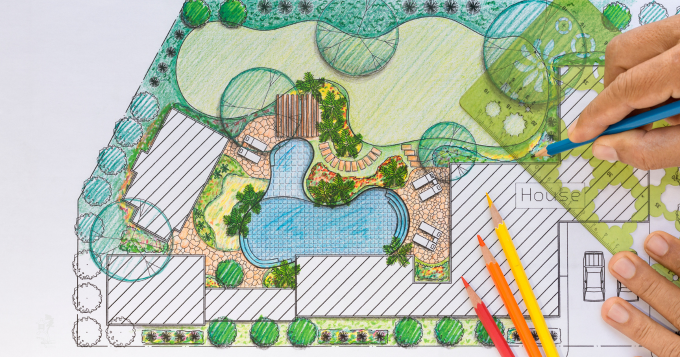Are you considering a landscaping project in San Francisco? There are several important steps to consider before starting. Understanding the four stages – design, plan, construct and inspect – of any landscaping project is key to ensuring you have the beautiful landscape you want while remaining within budget.
Keep in mind that you don’t need to be a landscape architect to know what you like or don’t like. However, some phases of a complex landscaping project require expert knowledge and careful planning. Your landscape design team has to be able to create both a visually stunning and functional outdoor living environment–not an easy task with many of San Francisco’s hilly backyard projects.
In this article, we discuss the 4 stages of a landscaping project, as they apply directly to San Francisco’s unique environment. Learn what they are, and what to expect as we move from one stage of the project to the next.
The 4 Stages of a Landscaping Project
Professionally developed landscape design can transform your outdoor space into an oasis by revitalizing the beauty of your home and creating a relaxing environment. Of course, there are other bonuses besides being able to sit on a patio and stare at your new Zen garden, koi pond, or blooming wildflowers.
After completing the project, your property value will have increased significantly, and so will the number of individuals willing to buy it if you wish to sell it. Landscaping can increase curb appeal and provide a pleasing way to handle soil erosion, one of the issues common to San Francisco’s hilly yards.
Whether designing a new landscape or renovating an existing one, launching landscape architecture projects requires specialized skills and expertise. It can be overwhelming if you don’t know where to start and the different design development stages. From construction drawings and project plans, building permits and architectural drawings, completing a landscape project is quite an undertaking.
A site visit and an initial consultation will help us get a feel for the possibilities, and will also help you better solidify the landscaping ideas in your head. It helps us prepare for the project; preparation is key to successfully implementing the proposed architectural landscape design.
Here are the four major stages of a landscape project that you shouldn’t miss.
Designs
The first stage of a landscaping project is the design phase. In this stage, you will work with our team to create a solid plan for your outdoor space and set project goals.
We consider your budget, preferences, and environmental factors. The next step is to draw a design that complements your architecture or residential landscape and resonates with your preferences.
Thanks to technological advancements, advanced software such as 3D modeling software makes this design stage easier. The software is instrumental in developing a visual representation of the final design before the landscaping project commences.
Plan
With the concept design at hand, the next stage is planning. Here, Tamate Landscaping will create a detailed project design plan which includes plant selections, materials, and the installation methods to be applied. We will analyze any existing zoning laws, regulations, post-occupancy, and permits the project must meet to avoid legal skirmishes with the local authorities. We also consider any contingency plans in the case of unexpected situations.
This stage of the landscaping process is vital. Every aspect of the project is reviewed and assessed before construction begins.
Construct
In the construction stage, we help you breathe life into your schematic design. We install the hardscape, which includes the walkways, retaining walls, patios, and other structural elements proposed by the landscape design.
If trees and plants are called, or you want a softscape with a blend of texture and color, we make sure you have the right design team and the right design. The two work hand in hand and help your landscape to stand out and appeal to the eyes.
The larger the space and complexity of the project, the more time it will take to complete. It’s best to agree on weekly milestones to efficiently monitor the progress and ensure it’s completed within the set timeframe.
Inspect
Inspection is the last stage of the landscaping project. As the name suggests, our landscaping team will check whether all the elements in the design plan were installed correctly and meet your expectations.
Concisely, this stage is crucial as it ensures that the project meets the quality standards and is completed according to the design.
Conclusion
Landscaping any backyard or front yard, hillside, walk way is a complex process that involves many stages, but these four are the most important. By understanding what each stage entails, you can prepare well and know what to anticipate at every juncture.
In a nutshell, the design stage is where the vision for the project is created, while the planning stage ensures that everything is accounted for before construction begins. The construction stage is where the plan comes to life, and the inspection phase ensures that the project is finished to your satisfaction.
At Tamate Landscaping, we work hard to ensure your finished landscape meets or exceeds your expectations. From the materials used to the quality of the work we provide, we’re proud of our team’s ability to transform San Francisco’s hillsides, desert rocks, and hard ground into beautiful gardens.
As experts in this field of work, we are deeply familiar with landscape architecture and construction. No matter how big or small your project is, we can help you turn it into something extra special. Let us turn your landscaping dreams into reality. Contact us today for a free consultation.



